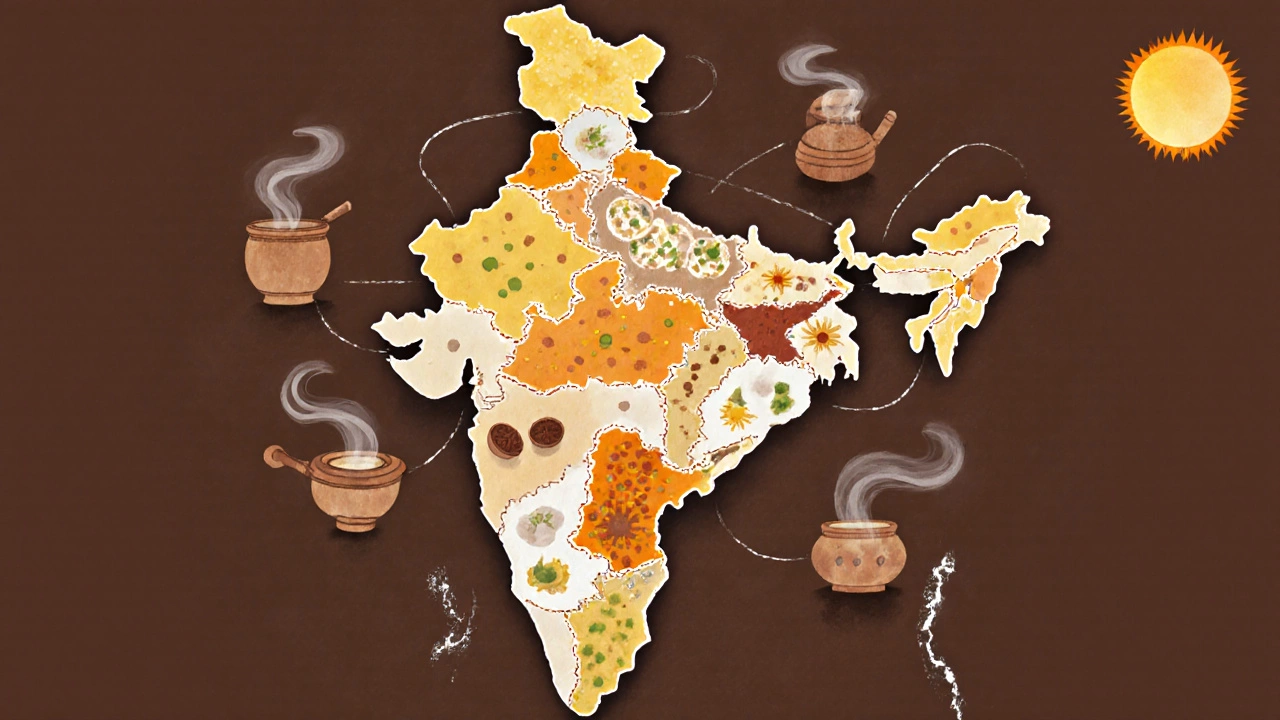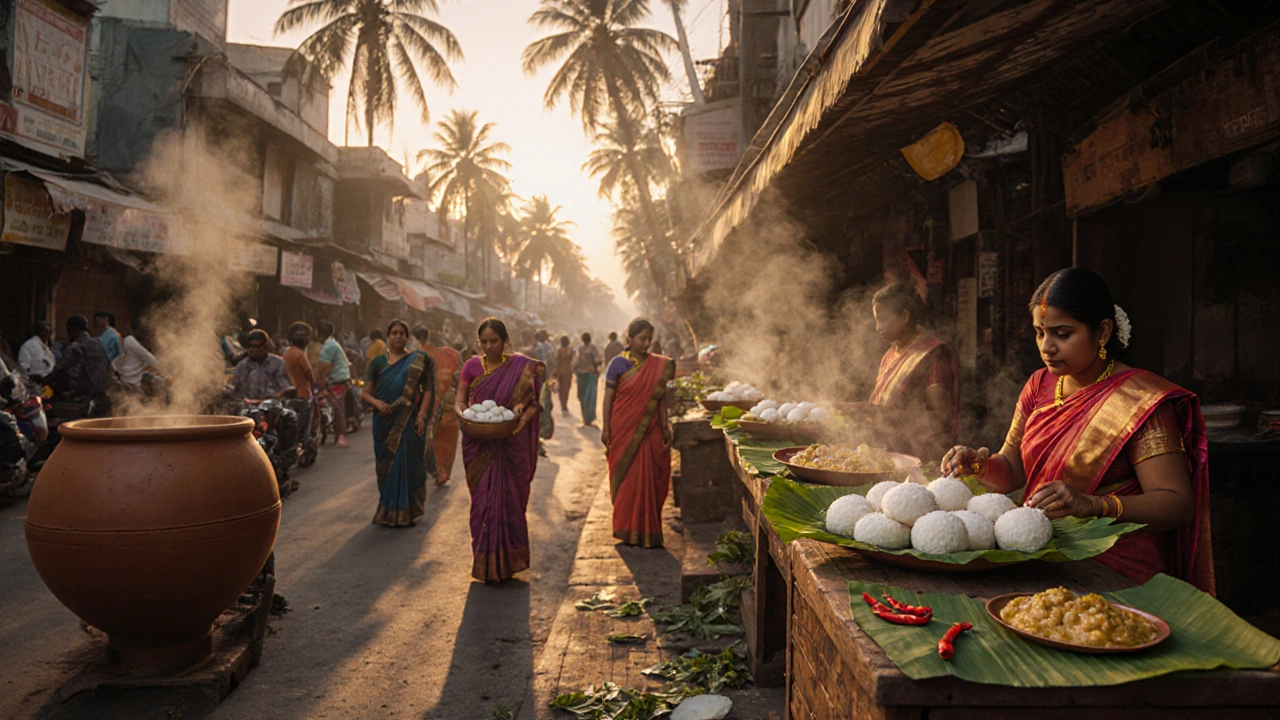Regional Indian Breakfast Finder
Discover traditional breakfasts from different regions of India. Select your preferred region to see popular morning meals with ingredients and preparation time.
Ask someone from Mumbai what they eat for breakfast, and they might say vada pav. Ask someone in Chennai, and they’ll tell you about idli sambar. In Delhi, it’s paratha with curd. In Kerala, it’s puttu and kadala curry. There’s no single ‘classic’ Indian breakfast-because India doesn’t have one. Instead, it has dozens, shaped by climate, crops, religion, and generations of family habits.
South India: Rice, Lentils, and Steam
In Tamil Nadu, Karnataka, Andhra Pradesh, and Kerala, breakfast isn’t about bread or eggs. It’s about fermented rice and lentil batter. The most common dish? Idli. These soft, fluffy steamed cakes are made from a batter of soaked rice and black gram dal, left to ferment overnight. The fermentation isn’t just for texture-it unlocks nutrients and makes the meal easier to digest. Serve them with sambar, a lentil-based vegetable stew spiced with tamarind, mustard seeds, and curry leaves, and coconut chutney, thick and slightly sweet.Close cousins of idli are dosa-thin, crispy fermented crepes-and uttapam, thicker and topped with onions, tomatoes, and chili. These are eaten daily by millions. In rural homes, women start grinding rice and dal before sunrise. In cities, you’ll find street vendors selling idli-dosa sets for under ₹30 ($0.35 USD). The ritual is simple: steam, serve, eat, repeat.
North India: Bread, Butter, and Heat
Up north, breakfast leans into wheat, dairy, and spice. The star is paratha-a layered, fried flatbread made from whole wheat flour. It’s stuffed with potatoes (aloo paratha), cauliflower (gobi paratha), or paneer, then cooked on a griddle with ghee or oil until golden and flaky. It’s paired with curd (yogurt), pickle (usually mango or lime), and sometimes a cup of masala chai.In Punjab, people eat makki di roti (corn flatbread) with sarson ka saag (mustard greens curry) in winter. In Delhi, chole bhature-fried bread with spicy chickpeas-is a weekend treat. Breakfast here isn’t light. It’s hearty, meant to fuel a long day of work. A single paratha can have 300+ calories, mostly from fat and carbs. But that’s the point. In colder regions, you need energy you can feel.
East India: Steamed Rice, Fish, and Sweetness
In West Bengal and Odisha, breakfast is often rice-based but less fermented than in the south. Panta bhat-rice soaked overnight in water-is a traditional monsoon dish. It’s eaten with fried green chilies, sliced onions, and sometimes salted fish. It’s not fancy, but it’s deeply cultural. In rural areas, it’s a way to stretch leftover rice and avoid waste.Another staple is luchi-deep-fried, puffy bread made from refined flour-served with alur dom (potato curry). In Assam, people eat chira (flattened rice) with jaggery and yogurt. Breakfast here is often sweet or sour, not spicy. The flavors are subtle, reflecting the region’s preference for balance over heat.

West India: Quick, Savory, and Street-Ready
In Maharashtra, breakfast is fast and portable. Vada pav-a spicy potato fritter sandwiched in a bun with chutneys-is the unofficial state breakfast. It’s sold from roadside stalls, wrapped in newspaper, eaten while walking. Poha (flattened rice cooked with turmeric, peanuts, and curry leaves) is another daily favorite. It’s quick to make, light on the stomach, and packed with flavor.In Gujarat, breakfast is often sweet. Dhokla-a steamed, fermented chickpea cake-is served with green chutney. It’s low-fat, high-protein, and eaten by vegetarians across the state. Many Gujarati families start the day with khichdi-a simple mix of rice and lentils-cooked with ginger and cumin.
Why These Meals Last
These breakfasts aren’t just recipes. They’re systems. Fermentation preserves food without refrigeration. Steaming uses minimal fuel. Ingredients like rice, lentils, and millet grow well in local soil. Spices like turmeric, cumin, and mustard seeds have antimicrobial properties-useful in hot, humid climates.Religion plays a role too. Many Hindus avoid meat in the morning. Jains don’t eat root vegetables. Muslims in Hyderabad eat keema paratha, but many families stick to vegetarian options. Breakfast in India is shaped by what’s allowed, what’s available, and what’s been passed down.
Even today, urban Indians who work 9-to-5 still make idli or poha at home. Why? Because it’s cheaper than toast and jam. Because it’s healthier than packaged cereal. Because it tastes like childhood.

What’s Missing From the Table
You won’t find bacon, eggs, or toast in most Indian homes for breakfast. That’s not because they’re unknown-it’s because they’re unnecessary. India has its own protein-rich staples: lentils, chickpeas, yogurt, paneer, and fermented batter. You don’t need eggs when you have medu vada (lentil donuts) or upma (semolina cooked with vegetables).And you won’t find sugary cereals. Indian breakfasts are naturally low in added sugar. Sweetness comes from jaggery, coconut, or fruit-not processed syrup. Even when desserts like halwa appear at breakfast (common in some Punjabi households), they’re small portions, not bowls of cornflakes.
Modern Shifts
In metro cities, younger people are trying toast, smoothie bowls, and protein shakes. But even they often pair it with masala chai or a side of sambar. The old habits don’t vanish-they adapt. A Mumbai office worker might eat a vada pav on the way to work, then have a yogurt bowl for lunch. The fusion is real, but the roots stay strong.What’s unchanged? The morning rhythm. The sound of a mortar and pestle grinding spices. The smell of mustard seeds popping in hot oil. The quiet ritual of preparing food before the sun rises high. That’s the real classic Indian breakfast-not the dish, but the practice behind it.
What is the most popular Indian breakfast nationwide?
There’s no single most popular breakfast across India because the country is too diverse. But if you look at daily consumption, idli and poha are likely the top two. Idli dominates the south, while poha is common in Maharashtra, Gujarat, and parts of North India. Both are easy to make, vegetarian, and affordable-key reasons they’ve survived for centuries.
Is Indian breakfast healthy?
Most traditional Indian breakfasts are very healthy. Fermented foods like idli and dosa improve gut health. Lentils and rice provide complete protein. Vegetables in sambar and upma add fiber. Spices like turmeric and ginger have anti-inflammatory benefits. The only exceptions are fried versions like bhatura or deep-fried vadas, which are higher in fat. But even those are usually eaten occasionally, not daily.
Can I make Indian breakfast without a steamer?
Yes. You can steam idli and dhokla in a regular pot with a colander or heatproof plate placed above boiling water. Cover with a lid and steam for 10-15 minutes. For dosa, you just need a nonstick pan. Poha and upma cook on the stove in under 10 minutes. You don’t need special tools-just time and patience.
Why don’t Indians eat eggs for breakfast?
Many Indians don’t eat eggs for breakfast because of cultural and religious norms. A large portion of the population is vegetarian due to Hindu, Jain, or Sikh beliefs. Even among non-vegetarians, eggs are often seen as a lunch or dinner item, not a morning one. That said, in coastal areas like Kerala and West Bengal, egg curry and boiled eggs are common breakfasts. It varies by region and family.
What’s the quickest Indian breakfast to make?
The quickest is poha. It takes 8-10 minutes: rinse flattened rice, sauté mustard seeds and curry leaves in oil, add the rice, turmeric, peanuts, and lemon juice. Done. Upma is similar. Both use pre-cooked grains and require no fermentation. If you have leftover rice, khichdi can be made in 15 minutes with lentils and spices.

